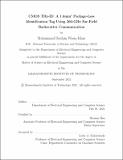CMOS THz-ID: A 1.6mm² Package-Less Identification Tag Using 260-GHz Far-Field Backscatter Communication
Author(s)
Khan, Muhammad Ibrahim Wasiq
DownloadThesis PDF (4.176Mb)
Advisor
Han, Ruonan
Terms of use
Metadata
Show full item recordAbstract
Radio Frequency Identification (RFID) tags have been widely used for counterfeit mitigation, authentication and supply chain management. Small form factor, power efficiency and cost are the important requirements of these tags which are often limited by off-chip antenna and packaging. Operating at Terahertz (THz) frequency removes these limitations by enabling on-chip antenna array within mm-size with sufficient gain. In this thesis, I present an ultra-small identification tag that is entirely built in a CMOS chip without external components. The usage of backscatter communications at 260 GHz enables full integration of a 2×2 patch antenna array. For chip compactness and minimum interference caused by direct wave reflection, the backscatter signal is frequency-shifted by 2 MHz and radiated with cross-polarization from the same antenna array. Such a configuration also, for the first time for RF tags, enables beam-steering for enhanced link budget. The presented tag has a peak power consumption of 21 𝜇W and can be powered by a chip-wide array of photodiodes. Using a low-cost 65-nm bulk CMOS technology, the THz-ID chip has an area of only 1.6 mm^2 and demonstrates measured downlink speed of 100 kbps and upload speed of 2 kbps across 5 cm distance from the reader. The tag-reader authentication/communication protocol is fully demonstrated using external tag power and partially demonstrated using the tag-integrated photo-voltaic powering. The tag size is the smallest among all prior RFIDs using far-field communications.
Date issued
2021-09Department
Massachusetts Institute of Technology. Department of Electrical Engineering and Computer SciencePublisher
Massachusetts Institute of Technology